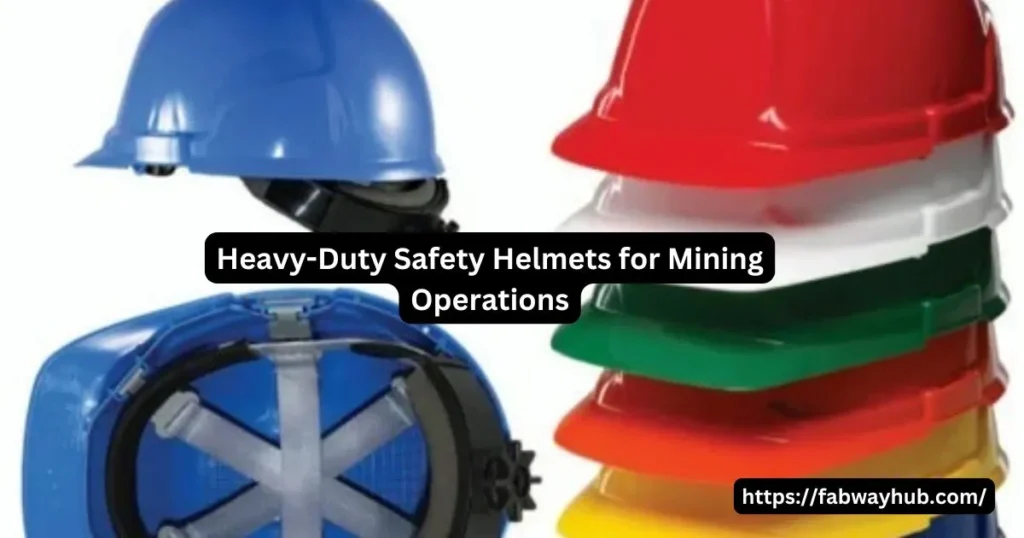Introduction:
Mining is considered one of the most dangerous occupations in the world. The daily hazards of work can range from debris to the Elements In these high-risk environments, safety protocols aren’t optional — they’re mandatory Heavy-Duty Safety Helmets for Mining Operations Of these measures, protective headgear is the most deadliest guardian of moon miners.
Mining accidents often result in head injuries, some of which could be very dangerous or debilitating and affect workers forever. One of the simplest but most effective ways to mitigate these hazards is to ensure that every worker is wearing the right safety helmet. Let’s take a look at the reasons behind the necessity of these helmets and how they are revolutionizing mining safety.
Heavy-Duty Safety Helmets for mining operations and Their Using Industry
Safety helmets are not an ordinary gears preferred for safety but they are lifesavers. Heavy-duty helmets also protect miners from head injuries due to falling rocks, equipment failure, slips or falls and are designed to work under extreme conditons. Helmets limit the severity of an injury by absorbing and dispersing the force of an impact.
Aside from protection, modern helmets often come equipped with built-in features, such as lights and/or communications systems, allowing workers to do their jobs more effectively. Not only do these helmets are necessary for personal protection of the miners, but also for the productivity of the mining operations.
First and foremost: What are the features in heavy-duty mining helmets
Durable Materials
Mining helmets are made of sturdy materials including as polycarbonate and ABS plastics. Not only are these materials lightweight, but they are also impact resistant, making them durable in even the toughest environments.
Impact Resistance
The single most important function of any safety helmet is impact energy absorption and dissipation. The construction of heavy-duty helmets usually utilizes multiple layers, such as an outer shell and inner padding that offer better protection.
Ventilation and Comfort
Mining workplaces normally are hot and humid so comfort must come first. Many modern helmets incorporate ventilation systems designed to keep workers cool, reducing fatigue during extended shifts.
Built-In Accessories
Some high-tech helmets already come with accessories such as LED lights to enhance visibility, visors to protect the eyes, and communication devices, which also help to work better as a team.
Different Types of Safety Helmets for Mining
Basic Helmets
These are for standard protection mode and useful in general mining activities.
Advanced Helmets
These helmets, equipped with smart technologies, are integrated with sensors for monitoring health and environmental conditions.
Customized Helmets
Some mines need specific helmets for safety purposes, whether underground mining or hazardous materials.
Adherence to Safety Standards
Safety helmets must follow strict guidelines such as OSHA and ANSI regulations. Compliance ensures that helmets offer sufficient protection and meet industry standards. Global Mining Organization: Global mining operations must adhere to international standards such as ISO certifications.
Innovations in Mining Head Protection
Smart Helmets
Mining is set to be transformed by smart helmets. Outfitted with sensors, they can track environmental threats, worker health and real-time locations.
Enhanced Lighting Systems
Helmets embedded with LED lighting provide illumination for miners working in dimly lit settings, minimizing potential accidents.
Table of Contents
How to Choose a Mining Helmet
To select an appropriate helmet, jobsites must review the needs of the worksite, evaluate the features of available options and consider the budget. Durability, comfort, and extra technologies should be taken into account cautiously.
Advantages of Heavy-Duty Safety Helmets
- Lesser Injuries: The Heavy-Duty Safety helmets reduces the chances of getting head injuries dramatically.
- Provide Better Productivity: If workers feel safe, they put more focus on their work.
- Enhanced Morale: Safety is essential in establishing confidence and trust.
Maintenance Tips for Mining Helmets
Cleaning Guidelines
- Remove dirt from helmets to keep visiblity clear.
Regular Inspection
- First, checking for cracks or damaged polycarbonate outer shells to figure out when helmets need replacing.
Replacement Schedules
- Not even the toughest helmets are immortal. Rehash and Replace helmets every 3-5 years or after a big impact for better safety.

Difficulties with Helmets Usage Implementation
But some miners are reluctant to wear helmets, complaining they are uncomfortable or cumbersome. Education and training emphasizing helmet use increasingly needs to be built in to overcome this resistance.
Few mining companies have embraced the technology, developing case studies of success.
Since strict enforcement of the helmet rule, a good number of mining companies have seen workplace injuries cut significantly. Investing in high-quality safety gear pays dividends with these success stories.
Next generation of Mining Safety Helmets
Innovations in AI and IoT bring exciting prospects for the future of mining helmets. The party is only getting started, and with it anticipated features such as real-time hazard alerts and improved connectivity to take safety to the next level.
Conclusion
Mine safety is predicated on the use of heavy-duty safety helmets. They ensure the safety and productivity of workers — an essential foundation of success for mining operations. Quality helmets need to be invested with as well and it is not only a requirement of regulation but also a personal commitment to view the importance of workers.
FAQs
Why Safety Helmets Are Essential In Mining?
They protect workers against head injuries from falling objects, slips and equipment malfunctions.
Which materials are the most rugged for mining helmets?
Other common materials used are polycarbonate, aplastic materials including ABS and composite materials, which are strong and lightweight.
How Do Smart Helmets Increase Safety?
Smart helmets can monitor environmental hazards, worker health, and location to keep workers safe.
How often do you need to replace mining helmets?
Helmets need to be replaced every 3-5 years or after they take a big impact.
Best Innovations of mining helmets in 2023?
New innovations include integration of AI, real-time hazard monitoring and advanced communications systems.